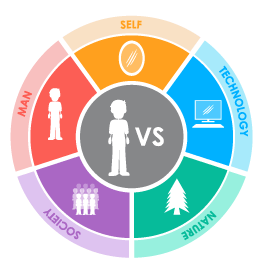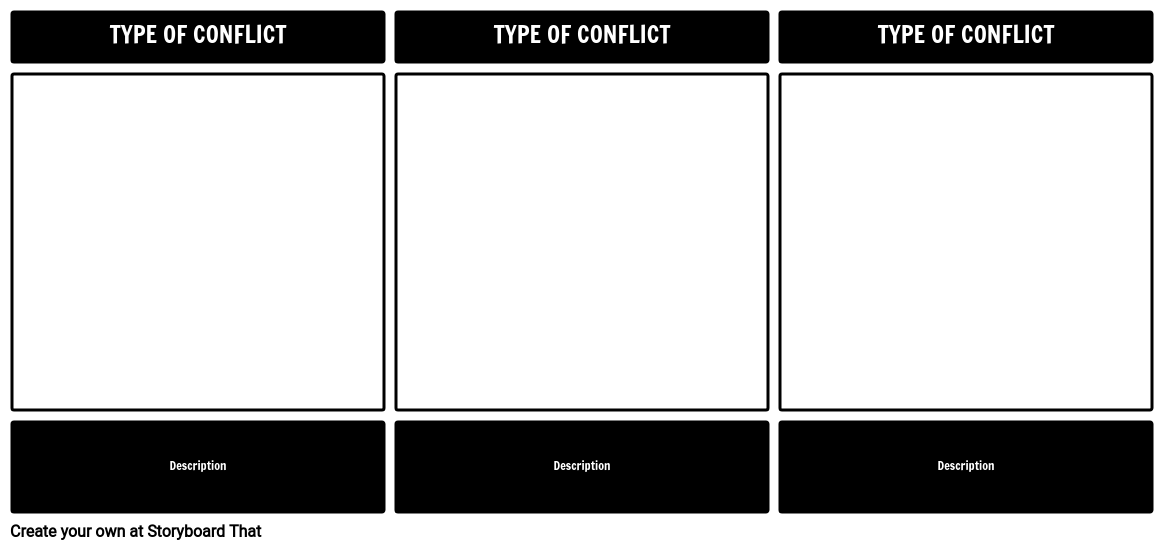Lesson Plan Overview
Storyboarding is an excellent way to focus on types of literary conflicts.
Having students create storyboards that show the cause and effect of different types of conflicts strengthens analytical thinking about literary concepts. Have your students choose an example of each literary conflict and depict them using the Storyboard Creator. In the storyboard, an example of each conflict should be visually represented, along with an explanation of the scene, and how it fits the particular category of conflict.
Examples of Literary Conflict in Divergent
CHARACTER vs. CHARACTER
Tris is in direct conflict with many other characters. Peter, in particular, strongly dislikes her, which creates a number of conflicts. Peter's fight with Tris during the initiation is just one of many times the two come into conflict with each other.
CHARACTER vs. SELF
Al's suicide creates an internal conflict for Tris. Although she cannot forgive him for trying to kill her, she never wanted him dead. She blames herself for his death and struggles to find peace of mind after his funeral.
CHARACTER vs. SOCIETY
Because she is divergent, Tris does not truly fit into any faction, and she struggles to find her place in society. Although Tris enjoys many aspects of both Abnegation and Dauntless life, she also find things to critique in each. Because the Erudite see divergence as a threat to their society, Tris's difference also puts her in a dangerous position.
CHARACTER vs. TECHNOLOGY
The simulation serum is a technology that creates the climactic conflict in the novel. The Erudite serum is used to control the Dauntless soldiers and start an all-out war between the factions. Tris is immune to the effects of the serum, but must face the chaos it causes.
Template and Class Instructions
(These instructions are completely customizable. After clicking "Copy Activity", update the instructions on the Edit Tab of the assignment.)
Student Instructions
Create a storyboard that shows at least three forms of literary conflict in Divergent.
- Identify conflicts in Divergent.
- Categorize each conflict as Character vs. Character, Character vs. Self, Character vs. Society, Character vs. Nature, or Character vs. Technology.
- Illustrate conflicts in the cells, using characters from the story.
- Write a short description of the conflict below the cell.
Lesson Plan Reference
Student Rubric
(You can also create your own on Quick Rubric.)
| Proficient | Emerging | Beginning | |
|---|---|---|---|
| Conflict Identification | Student identifies conflicts as directed and labels them accurately in their correct categories. | Student misidentifies one conflict or includes it in an incorrect category. | Student misidentifies two or more conflicts or includes them in incorrect categories. |
| Conflict Explanation | The storyboard text describes the specific example depicted, not just a general problem. The text clearly explains how the example reflects its particular type of conflict. | The storyboard text describes the specific example depicted, but may lack clarity. Text may fail to fully explain how the example reflects its particular type of conflict. | Storyboard is missing text or contains only partial and/or inaccurate information. |
| Storyboard Image and Effort | Student clearly shows effort to convey the setting, characters and specific scene of the book. The scene is clearly identifiable based on the graphic depiction. | Student attempts to convey the setting, characters, and specific scene through use of graphics, but the depiction may be confusing, disordered, or lack some detail. | Student does not clearly convey the setting, characters, and scene. |
| Spelling and Grammar | Student uses exemplary spelling and grammar. There are no errors. | Student makes one or two minor errors in spelling and grammar. | Student makes multiple errors in spelling and grammar. |
Lesson Plan Overview
Storyboarding is an excellent way to focus on types of literary conflicts.
Having students create storyboards that show the cause and effect of different types of conflicts strengthens analytical thinking about literary concepts. Have your students choose an example of each literary conflict and depict them using the Storyboard Creator. In the storyboard, an example of each conflict should be visually represented, along with an explanation of the scene, and how it fits the particular category of conflict.
Examples of Literary Conflict in Divergent
CHARACTER vs. CHARACTER
Tris is in direct conflict with many other characters. Peter, in particular, strongly dislikes her, which creates a number of conflicts. Peter's fight with Tris during the initiation is just one of many times the two come into conflict with each other.
CHARACTER vs. SELF
Al's suicide creates an internal conflict for Tris. Although she cannot forgive him for trying to kill her, she never wanted him dead. She blames herself for his death and struggles to find peace of mind after his funeral.
CHARACTER vs. SOCIETY
Because she is divergent, Tris does not truly fit into any faction, and she struggles to find her place in society. Although Tris enjoys many aspects of both Abnegation and Dauntless life, she also find things to critique in each. Because the Erudite see divergence as a threat to their society, Tris's difference also puts her in a dangerous position.
CHARACTER vs. TECHNOLOGY
The simulation serum is a technology that creates the climactic conflict in the novel. The Erudite serum is used to control the Dauntless soldiers and start an all-out war between the factions. Tris is immune to the effects of the serum, but must face the chaos it causes.
Template and Class Instructions
(These instructions are completely customizable. After clicking "Copy Activity", update the instructions on the Edit Tab of the assignment.)
Student Instructions
Create a storyboard that shows at least three forms of literary conflict in Divergent.
- Identify conflicts in Divergent.
- Categorize each conflict as Character vs. Character, Character vs. Self, Character vs. Society, Character vs. Nature, or Character vs. Technology.
- Illustrate conflicts in the cells, using characters from the story.
- Write a short description of the conflict below the cell.
Lesson Plan Reference
Student Rubric
(You can also create your own on Quick Rubric.)
| Proficient | Emerging | Beginning | |
|---|---|---|---|
| Conflict Identification | Student identifies conflicts as directed and labels them accurately in their correct categories. | Student misidentifies one conflict or includes it in an incorrect category. | Student misidentifies two or more conflicts or includes them in incorrect categories. |
| Conflict Explanation | The storyboard text describes the specific example depicted, not just a general problem. The text clearly explains how the example reflects its particular type of conflict. | The storyboard text describes the specific example depicted, but may lack clarity. Text may fail to fully explain how the example reflects its particular type of conflict. | Storyboard is missing text or contains only partial and/or inaccurate information. |
| Storyboard Image and Effort | Student clearly shows effort to convey the setting, characters and specific scene of the book. The scene is clearly identifiable based on the graphic depiction. | Student attempts to convey the setting, characters, and specific scene through use of graphics, but the depiction may be confusing, disordered, or lack some detail. | Student does not clearly convey the setting, characters, and scene. |
| Spelling and Grammar | Student uses exemplary spelling and grammar. There are no errors. | Student makes one or two minor errors in spelling and grammar. | Student makes multiple errors in spelling and grammar. |
How Tos about Literary Conflict in Divergent
Quickly assess students’ understanding of literary conflict with exit tickets
Use exit tickets at the end of your lesson to gauge student comprehension of literary conflict types. Provide each student with a small slip of paper and ask them to write an example of one conflict from ‘Divergent’ and label its type. This strategy gives you immediate feedback and helps identify areas that need review.
Model creating a sample conflict storyboard before students start
Demonstrate the process by making a quick storyboard example on the board or projector. Show how to choose a scene, identify the conflict type, and add a short explanation. This gives students a clear template and builds their confidence for the activity.
Encourage peer feedback on storyboards
Pair students or form small groups to review and discuss each other's storyboards. Guide students to give specific feedback on conflict types and scene explanations. This collaborative review deepens understanding and fosters a supportive classroom environment.
Display finished storyboards to spark classroom discussion
Showcase student work on a bulletin board or digitally. Invite students to explain their storyboard choices and conflict types. This creates opportunities for whole-class discussion and reinforces key literary concepts for everyone.
Frequently Asked Questions about Literary Conflict in Divergent
What are the main types of literary conflict in Divergent?
Divergent features several types of literary conflict, including Character vs. Character (Tris vs. Peter), Character vs. Self (Tris's guilt over Al's death), Character vs. Society (Tris's struggle as a Divergent), and Character vs. Technology (the simulation serum). Each conflict helps drive the story and develop the characters.
How can students identify and illustrate literary conflicts in Divergent?
Students can identify literary conflicts in Divergent by looking for moments where the main character faces challenges from other characters, internal struggles, societal pressures, or technology. Using a storyboard, they can visually represent these scenes and add brief explanations to show how each fits a conflict type.
Why is storyboarding effective for teaching literary conflict in Divergent?
Storyboarding helps students visualize and analyze different conflicts in Divergent. By creating scenes and explanations, students gain a clearer understanding of how conflict shapes characters and plot, and they practice higher-order thinking by categorizing and interpreting events.
What is an example of Character vs. Society conflict in Divergent?
An example of Character vs. Society in Divergent is Tris's struggle to fit into a faction as a Divergent. Her unique abilities put her at odds with the rules and expectations of her society, making her a target and forcing her to question where she belongs.
What steps should teachers follow to create a literary conflict lesson using storyboards for Divergent?
Teachers should ask students to choose examples of at least three conflict types from Divergent, illustrate each in a storyboard cell, and write a short description of the conflict. This helps students categorize and explain the conflicts while engaging creatively with the text.
More Storyboard That Activities
Divergent
Testimonials

“By using the product, they were so excited and they learned so much...”–K-5 Librarian and Instructinal Technology Teacher

“I'm doing a Napoleon timeline and I'm having [students] determine whether or not Napoleon was a good guy or a bad guy or somewhere in between.”–History and Special Ed Teacher

“Students get to be creative with Storyboard That and there's so many visuals for them to pick from... It makes it really accessible for all students in the class.”–Third Grade Teacher
© 2026 - Clever Prototypes, LLC - All rights reserved.
StoryboardThat is a trademark of Clever Prototypes, LLC, and Registered in U.S. Patent and Trademark Office








